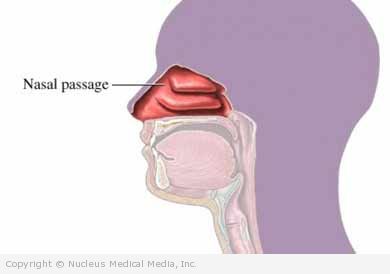(Hay Fever; Seasonal Allergies)
Allergic rhinitis – Definition
Allergic rhinitis is the set of symptoms that occurs when you breathe in substances you are allergic to. These substances are called allergens and are small proteins.
- Seasonal (intermittent) allergic rhinitis (sometimes called hay fever or rose fever) — This occurs during times of the year when allergens are in the air, like spring, summer, and fall. The most common allergen are tree, grass or weed pollens.
- Perennial (persistent) allergic rhinitis — This condition is caused by allergens that may be present year round. These may include chemicals, dust, dust mites, cockroaches, animal dander, or mold spores. Symptoms may be present any time of year.

Allergic rhinitis – Causes
An allergic reaction occurs when your body’s immune system overreacts to an allergen. When you breathe in an allergen, cells in your nasal passages release a chemical called histamine. Histamine causes your nose to feel itchy and also causes swelling and mucus production in the nasal passages.
Allergic rhinitis – Risk Factors
These factors increase your chance of developing allergic rhinitis. Tell your doctor if you have any of these risk factors:
- Family members with allergic rhinitis, eczema, or asthma
- Eczema
- Asthma
- Food allergies
Allergic rhinitis – Symptoms
Allergic rhinitis can cause the following symptoms:
- Sneezing
- Itching in the nose, eyes, throat, ears
- Red, watery eyes
- Runny nose, nasal congestion
- Sinus pressure
- Postnasal drip and cough
- Headache
- Dark circles under your eyes
Allergic rhinitis – Diagnosis
Your doctor will try to find out which allergens you are allergic to. Your doctor may refer you to an allergist or immunologist. This is a doctor who specializes in allergies.
Tests may include:
Skin Prick Test
A tiny bit of an allergen is placed under the skin with a needle. The doctor watches to see if the skin in that area becomes red, raised, and itchy. This can be done for multiple allergens at the same time.
RAST Testing
A small sample of blood is taken and tested for different allergens.
Provocation Testing
You breathe in air containing an allergen. The doctor will watch to see if you have an allergic reaction, such as wheezing or trouble breathing. This test is usually reserved for research settings.
Allergic rhinitis – Treatment
The most effective way to treat allergies is to avoid the allergen. Since this can sometimes be difficult or impossible, other treatments are available.
Treatments may include:
Medications
- Topical corticosteroids — nasal sprays that decrease swelling in the nasal passages
- Mast cell inhibitors — nasal sprays that interfere with the chemical reactions leading to histamine release
- Antihistamines — block the action of histamine; available as nasal spray, pill, or syrup
- Decongestants — decrease congestion by constricting blood vessels, taken as pills or as a nasal spray
- Note: Use of the nasal spray may lead to rebound congestion.
Immunotherapy (Allergy Shots) and Sublingual Therapy
With immunotherapy, very small amounts of allergens are injected over weeks, months, or even years. The goal is to make your body’s immune system less sensitive to those allergens. This treatment may be effective in reducing or eliminating the symptoms of allergic rhinitis.
There’s another, similar type of treatment called sublingual immunotherapy. It involves placing small amounts of allergens under the tongue. This treatment is more popular in Europe and is not approved in the United States. While it has shown to reduce symptoms in some studies, more research is needed.
If you are diagnosed with allergic rhinitis, follow your doctor’s instructions.
Allergic rhinitis – Prevention
The following strategies may help prevent allergic rhinitis:
- Stay inside during the morning hours when pollen counts are highest.
- Avoid outside activities during the time of year when the trees, grasses, weeds, or molds are blooming.
- Keep the windows of your house and car closed to keep pollen out.
- Use an air conditioner to reduce indoor humidity and to prevent mold and mildew growth.
- Clean your air conditioner’s filters regularly.
- Consider running an air purifier in your home, especially in your bedroom.
- Use vacuum cleaners and air conditioners with HEPA filters to trap allergens.
- Decrease or avoid outdoor activities on hot summer days, when ozone levels may make your symptoms worse.
- Cover pillows and mattresses with vinyl covers to reduce your exposure to dust mites.
- Wash bedding weekly in very hot water.
- Use fewer dust-collecting items, such as curtains, bed skirts, carpeting, and stuffed animals, especially in your bedroom.
- If you can’t avoid having a furry pet, vacuum frequently and keep your pet out of bedrooms and other rooms with carpets.
